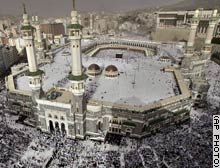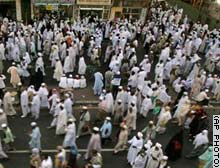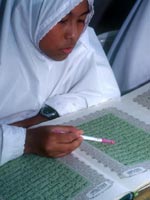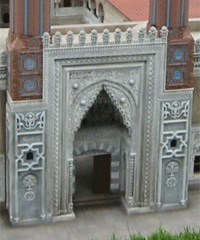| (insert your NIE or newspaper logo here) |
Weekly Online LessonOnline Lesson ArchiveGrade Level: 7-10
|
Muslim Devotion & Innovation
 After
gathering in Mecca, Saudi Arabia, over the last week, about two million
Muslims entered the first official day of Hajj on Sunday,
January 8, 2006.
After
gathering in Mecca, Saudi Arabia, over the last week, about two million
Muslims entered the first official day of Hajj on Sunday,
January 8, 2006.
The Hajj is a pilgrimage that every Muslim must undertake, if possible, at least once in his or her lifetime, fulfilling the fifth pillar of the religion's five basic tenets.
But the point is not just to step foot in the sacred city and then head for home. Once there, pilgrims pray and go through prescribed rites for a week as part of their spiritual rebirth.
Islam is the fastest growing and second most popular religion in the world. It's estimated that there are over one billion Muslims worldwide, with several million residing in the U.S.
So this week, you'll be delving into Islam—learning about the religion's basic principles and how it compares to other popular religions. You'll also discover how Islam has helped boost the spread of knowledge and innovation over the centuries.
Islam's Five Pillars
 Begin
your journey by exploring the basic principles of Islam: Empire
of Faith at PBS.
Begin
your journey by exploring the basic principles of Islam: Empire
of Faith at PBS.
Start with learning about the Faith of Islam.
In this section, you'll discover what Allah means, and you'll learn about the Five Pillars: Belief, Worship, Fasting, Almsgiving, and Pilgrimage.
What is Muhammad's relationship to God? What are some of the differences between Islam and Judeo-Christian beliefs and practices? Along with Muhammad, who is another prophet to whom Hajj rituals are tied?
As you may already know, these principles are part of Islam's foundation—the Koran & Tradition.
How was the Koran created? How did its teachings spread? Why did the spread of Islam also contribute to the spread of other knowledge? What is the difference between the writings of the Koran and what are referred to as the Traditions?
In People of the Book, you'll uncover more ties between Islam, Judaism, and Christianity. For example, why is Abraham a common key figure in all three religions?
Make sure to also review the snapshot of Islam Today.
 What is the difference between Sunni and Shiite?
In what ways might a Muslim majority influence a nation's social
and political structure?
What is the difference between Sunni and Shiite?
In what ways might a Muslim majority influence a nation's social
and political structure?
Now, take a look at Islamic Culture, spanning the realms of Art, Architecture, and Literature.
For what reasons do these cultural expressions in the Islamic world differ from those in a Christian setting?
In reviewing the previous sections, you likely noticed that Islam boosted the spread of knowledge. This is because self-improvement of the individual and the betterment of society are inherent in a Muslim's religious duty.
Such searching for and sharing of knowledge led to profound Innovation—in Algebra and Trigonometry, Engineering, Astronomy, Medicine, and in Paper & Publishing.
In what ways do use these innovations in our daily lives today?
Next, get more familiar with Muhammad and a few of Islam's other key Profiles.
How exactly did the places of Medina and Mecca become focal points in Islam tradition? In what regions did Saladin, Mamun, Rumi, Mehmed, and Suleyman live? In what ways did they influence the spread of Islam? In what ways did they influence the arts and sciences?
Muslim Heritage
 As
you've discovered, the Islamic religion not only served as spiritual
guidance to some over the centuries, it also served as a tool for spreading
change and innovation.
As
you've discovered, the Islamic religion not only served as spiritual
guidance to some over the centuries, it also served as a tool for spreading
change and innovation.
Now, let's dig deeper into Islam's influence at the Muslim Heritage site.
Begin by reviewing the Timeline.
As you mouse over the dates to learn more about each event, make note of the other milestones marked on the timeline for reference.
Which concepts, research, or innovations do we continue to rely upon today?
Next, explore the Virtual Civilization through the interactive tour, checking out a few of the key Personalities, Major Cities, Institutions, Discoveries, and Monuments of the Muslim World. Click on each icon to read more about that person, place, or topic.
If you have time, browse through other Topics highlighted at this site, like The Beginning of the Paper Industry, some of the Earliest maps of America, Muslim Contribution to Chemistry, and The Muslim Agricultural Revolution.
In what ways have the essential principles and teachings of Islam contributed to the development and stability of civilization as a whole?
Newspaper Activities
Get current issues of The Salt Lake Tribune and collect any articles about Muslims, including personal stories or specific Islamic sects or populations. Using a highlighter, highlight words in each article that relate to Islam or being a Muslim. For example, quotes that include the word Allah or Koran ; phrases that use either term of Sunni or Shiite; references to a mosque, prayer, belief, etc. Individually or as a class, sort articles based on the location (by country) of the featured news. File the articles in a folder for each country. After collecting articles for two weeks or more, open each folder and evaluate the articles covering each nation. As a class, discuss what Muslim-related events, activities, or personal stories are being reported in each country and why. Summarize the news in a list and post alongside a world map. Discuss the "bigger picture" of any pattern you or other students notice.
Alternatively, cut out photos of items or processes that are based on innovations inspired or spread by early Muslims. Create a collage, labeling each item and noting how it can be traced back to Islam influence (use the Muslim Heritage topics library for help, if needed).
© Copyright 2006
Learners Online, Inc.
